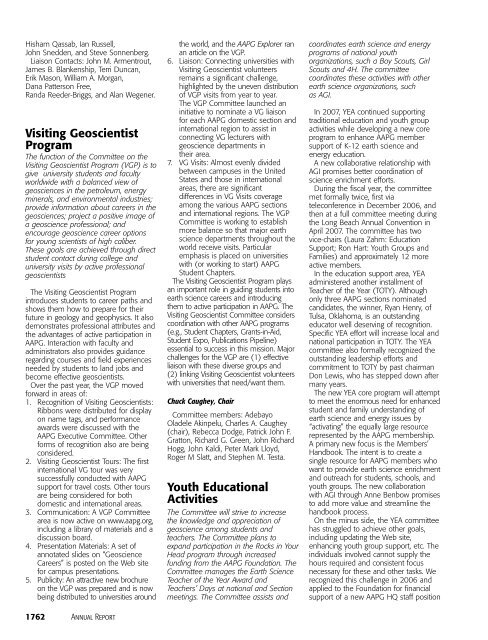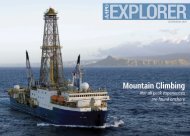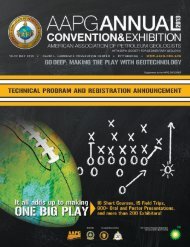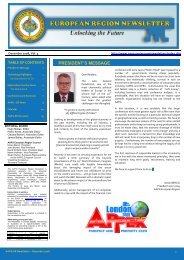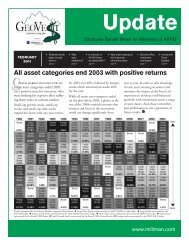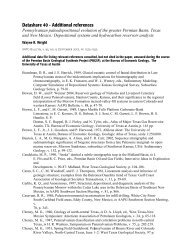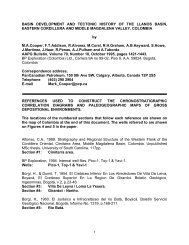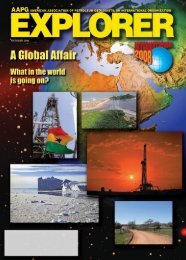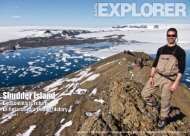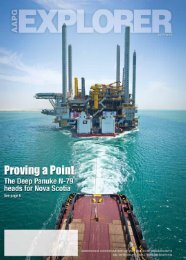2009 Annual Report - American Association of Petroleum Geologists
2009 Annual Report - American Association of Petroleum Geologists
2009 Annual Report - American Association of Petroleum Geologists
You also want an ePaper? Increase the reach of your titles
YUMPU automatically turns print PDFs into web optimized ePapers that Google loves.
Hisham Qassab, Ian Russell,<br />
John Snedden, and Steve Sonnenberg.<br />
Liaison Contacts: John M. Armentrout,<br />
James B. Blankenship, Terri Duncan,<br />
Erik Mason, William A. Morgan,<br />
Dana Patterson Free,<br />
Randa Reeder-Briggs, and Alan Wegener.<br />
Visiting Geoscientist<br />
Program<br />
The function <strong>of</strong> the Committee on the<br />
Visiting Geoscientist Program (VGP) is to<br />
give university students and faculty<br />
worldwide with a balanced view <strong>of</strong><br />
geosciences in the petroleum, energy<br />
minerals, and environmental industries;<br />
provide information about careers in the<br />
geosciences; project a positive image <strong>of</strong><br />
a geoscience pr<strong>of</strong>essional; and<br />
encourage geoscience career options<br />
for young scientists <strong>of</strong> high caliber.<br />
These goals are achieved through direct<br />
student contact during college and<br />
university visits by active pr<strong>of</strong>essional<br />
geoscientists<br />
The Visiting Geoscientist Program<br />
introduces students to career paths and<br />
shows them how to prepare for their<br />
future in geology and geophysics. It also<br />
demonstrates pr<strong>of</strong>essional attributes and<br />
the advantages <strong>of</strong> active participation in<br />
AAPG. Interaction with faculty and<br />
administrators also provides guidance<br />
regarding courses and field experiences<br />
needed by students to land jobs and<br />
become effective geoscientists.<br />
Over the past year, the VGP moved<br />
forward in areas <strong>of</strong>:<br />
1. Recognition <strong>of</strong> Visiting Geoscientists:<br />
Ribbons were distributed for display<br />
on name tags, and performance<br />
awards were discussed with the<br />
AAPG Executive Committee. Other<br />
forms <strong>of</strong> recognition also are being<br />
considered.<br />
2. Visiting Geoscientist Tours: The first<br />
international VG tour was very<br />
successfully conducted with AAPG<br />
support for travel costs. Other tours<br />
are being considered for both<br />
domestic and international areas.<br />
3. Communication: A VGP Committee<br />
area is now active on www.aapg.org,<br />
including a library <strong>of</strong> materials and a<br />
discussion board.<br />
4. Presentation Materials: A set <strong>of</strong><br />
annotated slides on “Geoscience<br />
Careers” is posted on the Web site<br />
for campus presentations.<br />
5. Publicity: An attractive new brochure<br />
on the VGP was prepared and is now<br />
being distributed to universities around<br />
1762 <strong>Annual</strong> <strong>Report</strong><br />
the world, and the AAPG Explorer ran<br />
an article on the VGP.<br />
6. Liaison: Connecting universities with<br />
Visiting Geoscientist volunteers<br />
remains a significant challenge,<br />
highlighted by the uneven distribution<br />
<strong>of</strong> VGP visits from year to year.<br />
The VGP Committee launched an<br />
initiative to nominate a VG liaison<br />
for each AAPG domestic section and<br />
international region to assist in<br />
connecting VG lecturers with<br />
geoscience departments in<br />
their area.<br />
7. VG Visits: Almost evenly divided<br />
between campuses in the United<br />
States and those in international<br />
areas, there are significant<br />
differences in VG Visits coverage<br />
among the various AAPG sections<br />
and international regions. The VGP<br />
Committee is working to establish<br />
more balance so that major earth<br />
science departments throughout the<br />
world receive visits. Particular<br />
emphasis is placed on universities<br />
with (or working to start) AAPG<br />
Student Chapters.<br />
The Visiting Geoscientist Program plays<br />
an important role in guiding students into<br />
earth science careers and introducing<br />
them to active participation in AAPG. The<br />
Visiting Geoscientist Committee considers<br />
coordination with other AAPG programs<br />
(e.g., Student Chapters, Grants-in-Aid,<br />
Student Expo, Publications Pipeline)<br />
essential to success in this mission. Major<br />
challenges for the VGP are (1) effective<br />
liaison with these diverse groups and<br />
(2) linking Visiting Geoscientist volunteers<br />
with universities that need/want them.<br />
Chuck Caughey, Chair<br />
Committee members: Adebayo<br />
Oladele Akinpelu, Charles A. Caughey<br />
(chair), Rebecca Dodge, Patrick John F.<br />
Gratton, Richard G. Green, John Richard<br />
Hogg, John Kaldi, Peter Mark Lloyd,<br />
Roger M Slatt, and Stephen M. Testa.<br />
Youth Educational<br />
Activities<br />
The Committee will strive to increase<br />
the knowledge and appreciation <strong>of</strong><br />
geoscience among students and<br />
teachers. The Committee plans to<br />
expand participation in the Rocks in Your<br />
Head program through increased<br />
funding from the AAPG Foundation. The<br />
Committee manages the Earth Science<br />
Teacher <strong>of</strong> the Year Award and<br />
Teachers’ Days at national and Section<br />
meetings. The Committee assists and<br />
coordinates earth science and energy<br />
programs <strong>of</strong> national youth<br />
organizations, such a Boy Scouts, Girl<br />
Scouts and 4H. The committee<br />
coordinates these activities with other<br />
earth science organizations, such<br />
as AGI.<br />
In 2007, YEA continued supporting<br />
traditional education and youth group<br />
activities while developing a new core<br />
program to enhance AAPG member<br />
support <strong>of</strong> K-12 earth science and<br />
energy education.<br />
A new collaborative relationship with<br />
AGI promises better coordination <strong>of</strong><br />
science enrichment efforts.<br />
During the fiscal year, the committee<br />
met formally twice, first via<br />
teleconference in December 2006, and<br />
then at a full committee meeting during<br />
the Long Beach <strong>Annual</strong> Convention in<br />
April 2007. The committee has two<br />
vice-chairs (Laura Zahm: Education<br />
Support; Ron Hart: Youth Groups and<br />
Families) and approximately 12 more<br />
active members.<br />
In the education support area, YEA<br />
administered another installment <strong>of</strong><br />
Teacher <strong>of</strong> the Year (TOTY). Although<br />
only three AAPG sections nominated<br />
candidates, the winner, Ryan Henry, <strong>of</strong><br />
Tulsa, Oklahoma, is an outstanding<br />
educator well deserving <strong>of</strong> recognition.<br />
Specific YEA effort will increase local and<br />
national participation in TOTY. The YEA<br />
committee also formally recognized the<br />
outstanding leadership efforts and<br />
commitment to TOTY by past chairman<br />
Don Lewis, who has stepped down after<br />
many years.<br />
The new YEA core program will attempt<br />
to meet the enormous need for enhanced<br />
student and family understanding <strong>of</strong><br />
earth science and energy issues by<br />
“activating” the equally large resource<br />
represented by the AAPG membership.<br />
A primary new focus is the Members’<br />
Handbook. The intent is to create a<br />
single resource for AAPG members who<br />
want to provide earth science enrichment<br />
and outreach for students, schools, and<br />
youth groups. The new collaboration<br />
with AGI through Anne Benbow promises<br />
to add more value and streamline the<br />
handbook process.<br />
On the minus side, the YEA committee<br />
has struggled to achieve other goals,<br />
including updating the Web site,<br />
enhancing youth group support, etc. The<br />
individuals involved cannot supply the<br />
hours required and consistent focus<br />
necessary for these and other tasks. We<br />
recognized this challenge in 2006 and<br />
applied to the Foundation for financial<br />
support <strong>of</strong> a new AAPG HQ staff position


